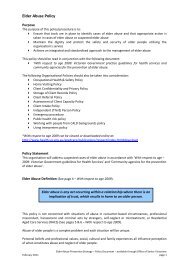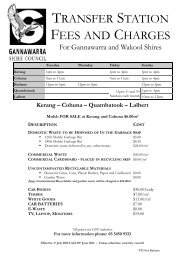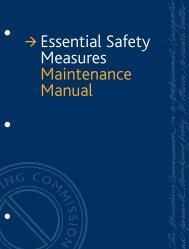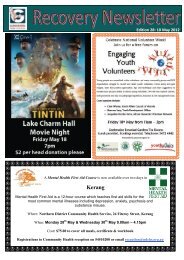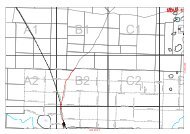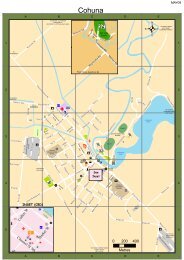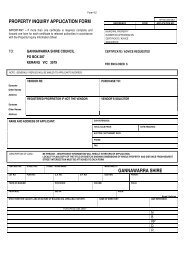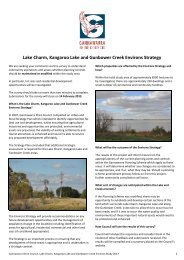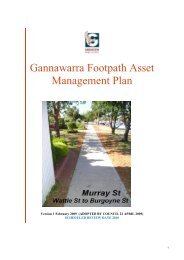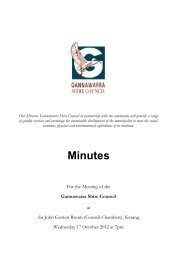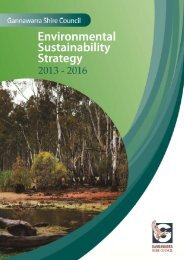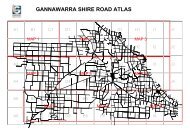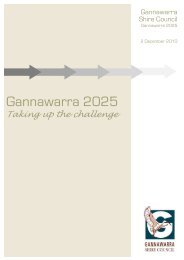Gannawarra Shire Heritage Study Stage One Volume One Thematic ...
Gannawarra Shire Heritage Study Stage One Volume One Thematic ...
Gannawarra Shire Heritage Study Stage One Volume One Thematic ...
Create successful ePaper yourself
Turn your PDF publications into a flip-book with our unique Google optimized e-Paper software.
During the economic depression of the 1930s, unemployed people from Melbourne were established<br />
in camps throughout the <strong>Shire</strong> to undertake specific government projects such as railway work, channel<br />
clearing, and road building.<br />
Although some soldier settlement took place after World War Two, for the most part closer settlement<br />
as an active policy was wound down from 1938.<br />
The closer settlement landscape<br />
A snapshot of closer settlement development in Cohuna in 1911 is provided in a report from the<br />
Weekly Times. It stated that seventeen new settler families had taken up irrigation blocks in the first few<br />
months of that year and were mostly involved in the growing of lucerne and dairying with a view to fruit<br />
cultivation. Twelve of the families had come to the area in response to the McKenzie-Mead delegation: ‘they<br />
are – with two exceptions – Englishmen with English wives and fresh-faced healthy children…and [they]<br />
consider that the bulk of the promises made to them by the delegation have been fulfilled.’ Four of them,<br />
wrote the reporter, were living in two-roomed cottages erected by the Government – other houses stood<br />
awaiting occupants. As to the farming experience possessed by an Irish settler, ‘[it] is represented on the right<br />
side of a decimal, but his coat is off and a shovel is raising blisters on his willing hands formerly troubled with<br />
writer’s cramp.’ Families were viewed as having the natural advantage of a secure labour force: ‘Mr Stone is a<br />
good type of the steady Gloucester farmer…This gentlemen is in an exceptional condition to go in for dairy<br />
farming, having a wife and nine children.’ Mr McKillop from Liverpool was described as ‘young, strong and<br />
anxious, and…assisted by a capable wife and family.’ Mr Woodward was to be aided in his dairying<br />
enterprise by ‘his wife and two buxom daughters.’ 57 Earlier, Russians, ‘ordinary middle-aged farmers – sturdy<br />
Russian yeomen inured to hardship’, had taken up land at McMillans near Cohuna in October 1909. 58<br />
Many of those who came were unhappy about living conditions. At Cohuna in 1911, new settlers<br />
complained that the two-roomed government cottages were inadequate for their needs and the promised<br />
railway line from Elmore to Cohuna was nonexistent. Settlers at Mead formed an association in 1911,<br />
ostensibly to provide each other support and advice, however they were soon lobbying the government for<br />
houses, canals and railways. Locals argued that the best land was reserved for the newcomers and that only<br />
‘stiff, clayey land unsuited for closer settlement purposes’ was left for the Australians. 59 Russian families at<br />
McMillans (where today the land is still referred to as Siberia) soon departed. A local resident described the<br />
discomfort during the hot summer months where ‘they spent the…days sitting up to their necks in the channel<br />
behind Mr McWhae’s house and begged us as a favour to cut the reeds to insulate their ceilings.’ 60 Settlers’<br />
houses, ‘Government-built two-roomed cottages, with front verandahs, each a replica of the others…[and]<br />
57 "New Settlers." The Weekly Times, 7 January 1911.<br />
58 "Russians Settle at McMillans." The Cohuna Farmers Weekly, 31 March 2004. For a detailed study of immigrants who<br />
took up land on the Cohuna Estate see Murphy, "Where There's Mud There's Money: Irrigated Closer Settlement on<br />
Cohuna Estate First Subdivision 1909".<br />
59 "Developing Cohuna." The Weekly Times, 4 February 1911, 49.<br />
60 Gwenyth Gordon, Phyllis Hetherington, Rose Peatling and Mavis Spark, ed., Unlock the Land: A History of the<br />
Cohuna District 1875-1975 (Echuca: Riverina Herald Print, n.d.), 33.<br />
<strong>Gannawarra</strong> <strong>Shire</strong> <strong>Heritage</strong> <strong>Study</strong> <strong>Stage</strong> <strong>One</strong> <strong>Volume</strong> <strong>One</strong> <strong>Thematic</strong> Environmental History<br />
Robyn Ballinger (History in the Making) December 2008<br />
22



